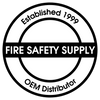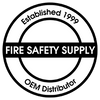Fire Safety Myths Debunked
Posted by the FSS Team on Sep 26th 2024
Debunking Fire Safety Myths: What You Need to Know
Fire safety is a crucial aspect of protecting lives and property, yet many people hold onto myths and misconceptions that can lead to dangerous situations. These myths often stem from misunderstandings or outdated information, and believing them can result in inadequate preparedness and response during a fire emergency. In this article, we’ll debunk some of the most common fire safety myths, providing accurate information and expert advice to help you ensure effective fire prevention and safety practices.
Myth 1: "Water Extinguishes All Fires"
One of the most widespread fire safety myths is the belief that water can extinguish any type of fire. While water is effective against certain types of fires, such as those involving ordinary combustibles (Class A fires), it can be dangerous and ineffective against others.
- Reality: Water should never be used on grease fires (Class K), electrical fires (Class C), or fires involving flammable liquids (Class B). Using water on these fires can cause the flames to spread or increase the risk of electrocution. Instead, use the appropriate fire extinguisher: a Class K extinguisher for grease fires, a CO2 or dry chemical extinguisher for electrical fires, and a foam or powder extinguisher for flammable liquid fires.
Myth 2: "Smoke Detectors Are Enough"
Many people mistakenly believe that simply installing smoke detectors is sufficient for complete fire protection. While smoke detectors are essential, they are just one part of a comprehensive fire safety strategy.
- Reality: Smoke detectors are vital for early detection, but they do not extinguish fires or aid in evacuation. It’s important to have a multi-layered approach to fire safety, including fire extinguishers, fire blankets, and a well-planned emergency exit strategy. Additionally, smoke detectors should be complemented with carbon monoxide detectors and, in some cases, fire sprinklers for added protection.
Myth 3: "Fires Won't Happen in New Buildings"
There’s a common misconception that new buildings, due to their modern construction and materials, are less likely to experience fires.
- Reality: Fires can occur in any building, regardless of age. In fact, modern construction materials, such as synthetic materials and lightweight wood, can burn faster and produce more toxic smoke than traditional materials. It’s crucial to implement fire safety measures in all buildings, new or old, including proper installation of fire safety equipment and regular maintenance checks.
Myth 4: "I Have Plenty of Time to Evacuate During a Fire"
Some people believe that they will have ample time to gather belongings and safely evacuate during a fire.
- Reality: Fires can spread rapidly, often doubling in size every minute. In just two minutes, a small fire can turn into a life-threatening situation. The smoke and toxic fumes produced by fires can incapacitate individuals within seconds, making quick evacuation critical. It's essential to prioritize getting out immediately when a fire alarm sounds, and to have an established and practiced evacuation plan in place.
Myth 5: "Leaving Doors Open Won't Make a Difference"
Another dangerous myth is the idea that leaving doors open as you evacuate doesn’t impact the fire’s spread.
- Reality: Closing doors behind you as you evacuate can significantly slow the spread of fire and smoke, buying precious time for everyone to escape and reducing damage to the property. This simple action can help contain the fire to a specific area, allowing firefighters to respond more effectively.
Expert Advice
To ensure effective fire safety, it's important to base your practices on accurate information and expert recommendations:
- Install the Right Equipment: Ensure your home or business is equipped with the correct type of fire extinguishers for different classes of fires, and that smoke and carbon monoxide detectors are properly installed and maintained.
- Create an Evacuation Plan: Develop a clear and practiced evacuation plan that includes multiple exit routes, designated meeting points, and roles for family members or employees.
- Conduct Regular Drills: Regular fire drills help familiarize everyone with the evacuation plan, reducing panic and confusion in the event of a real fire.
- Stay Informed: Keep up-to-date with fire safety guidelines from reliable sources such as the National Fire Protection Association (NFPA) and local fire departments.
Importance of Awareness
Fire safety is everyone’s responsibility, and awareness is key to preventing fire-related tragedies. By debunking common myths and understanding the true nature of fire risks, you can take proactive steps to protect yourself, your loved ones, and your property. Accurate knowledge and preparedness are your best defenses against the unpredictable and destructive power of fire. Don’t let myths endanger your safety—commit to learning and practicing effective fire safety measures today.
 Since 1999, Fire Safety Supply has been the go-to for fire suppression products, industrial dry chemical systems, high and low-pressure CO2, vehicles, and clean agents. We serve various types of industries such as restaurants, commercial kitchen, wineries, and more.
Since 1999, Fire Safety Supply has been the go-to for fire suppression products, industrial dry chemical systems, high and low-pressure CO2, vehicles, and clean agents. We serve various types of industries such as restaurants, commercial kitchen, wineries, and more.
